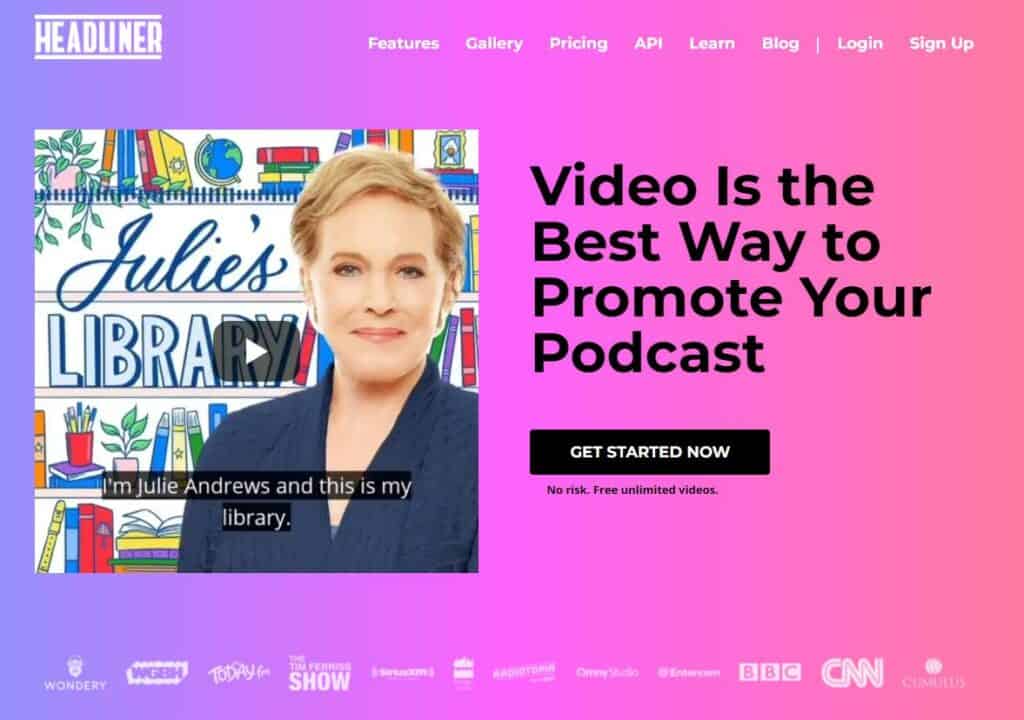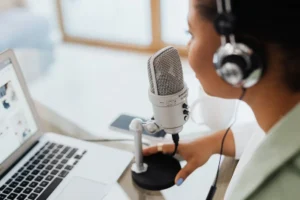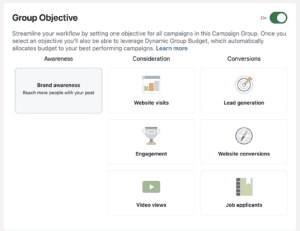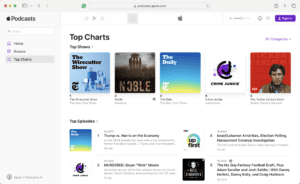Are you wondering whether to promote a podcast with Audiograms? Looking for more advice on how to do it?
Sharing your episodes is a key part of podcast promotion. But in order to drive traffic from social media to your show, you need to post highly engaging content. Text posts and images are great (and you should definitely use them) but you can drive a lot more traffic with podcast audiograms.
In this article, we’re going to explain podcast audiograms, show you some examples, and teach you how to create your own. (Don’t worry! They aren’t difficult to make.)
Create Audiograms for Free with Castos
Castos Growth Plan includes access to Headliner, allowing you to create audiograms at no additional cost. Click the button below to get started.

What are Podcast Audiograms?
Audiogram definition: A podcast audiogram is an image that’s converted into a video and layered with other elements on top, such as a waveform and/or transcriptions. Essentially, it combines visual arts, audio tracks, soundwaves, and text to create a highly shareable marketing asset.
Podcast audiograms function like a movie trailer. They use audio, visual, and text elements, along with a snippet of the episode, to grab viewers’ attention. They are far more enticing than a simple text link or a still image. Plus, they are unique to podcasts.
Most importantly, audiograms stand out from other types of social media content because they are unconventional. They pop out on a social media feed. They work on every social media platform that allows you to post video content.
Here’s an example of an audiogram from an episode of our Audience podcast.
WNYC, New York City’s public radio station WNYC was one of the first content creators to use audiograms. The format was a huge boost to their engagement levels: “On Twitter, the average engagement for an audiogram is 8x higher than a non-audiogram tweet and on Facebook some of our shows are seeing audiogram reach outperform photos and links by 58% and 83% respectively.”
In a Headliner study, they shared a podcast episode on Facebook in two different ways. The first was with a static image. The second was with a podcast audiogram. The audiogram generated five times more traffic.
That’s a pretty significant difference! This simple technique could quintuple the number of people who are exposed to your show. Imagine how much faster you could grow your audience with that kind of boost.
Examples of Podcast Audiograms
To give you an idea of what you can make with podcasts, here are a few examples. Notice how each of these posts use a captivating image and post copy. Some use waveforms and transcriptions.
1. McKinsey & Company
#ArtificialIntelligence has a growing role in predicting, preventing, and treating COVID-19 cases. Listen to my conversation with my friend, James Manyika, where we discuss biological sciences and investing in our technological future. https://t.co/Gwoah4NSDS. @McKinsey_MGI pic.twitter.com/ee3DnjW8Df
— Kevin Scott (@kevin_scott) August 13, 2020
2. Headgum
Season 2 of Newcomers dropped this week! Listen to @laurenlapkus & @nicolebyer talk The Fellowship of The Ring with @Gabrus!
— Headgum (@headgum) August 21, 2020
🎧 LISTEN 🎧@Spotify: https://t.co/7WFWR5bdsQ@ApplePodcasts: https://t.co/dVI8Z26ynh pic.twitter.com/CKQ0rouPfu
3.Girls Gotta Eat
New episode features our listeners’ most embarrassing F*ck My Phone moments 😭 listen on @Spotify! #spotifypodcasts pic.twitter.com/u3LOYfvl9m
— Girls Gotta Eat Podcast (@Girls_GottaEat) May 19, 2020
4. Paradox Podcast
For ep. #15 of the #ParadoxPodcast, I chatted w/ startup investor @m2jr about breakthrough insights, a lesson from a fishing trip with his Dad, stumbling into his 1st angel investment (Twitter) and a big issue facing our country almost no one talks about.https://t.co/HM5DJ0HNE4 pic.twitter.com/f6kmo0EFer
— Kyle Tibbitts (@KyleTibbitts) September 30, 2020
How to Make Podcast Audiogram
Fortunately, you don’t need graphic design skills or the ability to write code to create podcast audiograms. You just need the right tool.
While there are several tools to create an audiogram, we recommend Headliner. In fact, we like them so much that we worked with them to create custom Headliner integration in Castos. We want to help podcasters easily generate audiograms so promoting new content is a breeze.
Headliner is an app that lets you combine audio, video, gifs, captions, and animation to create unique videos, then share them across your social networks. The drag-and-drop editor is simple. No video editing experience is necessary. Headliner also offers multiple export sizes so every video is the right size for each social media channel.
Headliners free plan lets you create five videos per month without watermarks. It also includes 10 minutes of transcription per month and free sharing to social media.
Since Castos is integrated with Headliner, you can upload an episode to your Castos dashboard and immediately start creating podcast audiograms. The final video will sync with Castos so you’ll have all of your audio and video assets in one place.
Watch this video to learn exactly how this works:
Need help making a podcast audiogram? Read our full tutorial on how to make a podcast audiogram with Headliner.
Podcast Audiogram Best Practices
Now that you know why you should make podcast audiograms for each episode and how to get started, let’s go over some best practices to help you make effective audiograms that engage social media users and entice them to click.
Keep in mind, however, that there is no one-size-fits-all approach for making and sharing audiograms. But these tips will get you started.
1. Optimize audiograms for each platform
YouTube, Facebook, Instagram, Instagram, TikTok, Twitter, and other social media platforms require different dimensions for images and videos. If you use the same audiogram for them all, it will look odd and unpleasant on some platforms, so you’ll need multiple sizes.
All Castos Growth and Pro plan members can create audiograms and the final video asset will automatically sync with your Castos dashboard. See how Castos and Headliner work together.
Here’s what you need:
- A square audiogram for Facebook, Twitter, and Instagram feeds – 1080px by 1080px.
- A vertical audiogram for Instagram stories, IGTV, and TikTok – 1080px by 1920px.
- A widescreen audiogram for YouTube – 1920px by 1080px.
Here’s a typical square format:
Here’s an example of a vertical audiogram:
And here’s a widescreen audiogram:
2. Add a transcription/subtitles to your podcast audiograms
We strongly recommend adding some kind of text transcription to your podcast audiograms. According to a study by PLYmedia, subtitles increase the amount of time that users spend watching a video.
- Videos without subtitles/captions: Videos are watched about 66% of the way through. Only 47% watch the complete video.
- Videos with subtitles/captions: Videos are watched about 91% of the way through. 84% of people complete the whole video.
Plus, many people browse social media with their sound off. Text gives them the opportunity to enjoy your video without turning the volume up.
3. Use engaging images
Generally speaking, users are more likely to be interested in social media content if they find the visual element of the post appealing. Use unique, captivating images for your audiograms. Avoid using the same tired stock photos we see all over the web.
It also helps to use an image that relates to the content of the episode. For example, if your episode is about the clever architecture of a building, show the building in your image.
Images with people can boost your click-through rate by 95%. This is a great place to show the face of your guest or a stock photo of people that express a message similar to your episode.
4. Keep your podcast audiograms short and simple
The purpose of podcast audiograms is to drive traffic to your show, not to give away your content. You want them to use a podcast app or your podcast website where their downloads and listens will be tracked for your analytics.
Users don’t want to listen to an entire podcast episode on Twitter, so keep your audiogram short and simple. Use a brief clip that piques viewers’ interest and makes them want to learn more. Experiment with length (10 seconds vs. 30 seconds vs. 1 minute, etc.) to find what works best for you.
5. Make your headline interesting
The main text on your audiogram is one of the most important elements. It needs to capture the viewer’s attention right away. If they have autoplay turned off in their settings, your headline is the element that must entice them to click the play button.
Your headline doesn’t necessarily have to be the title of your episode. You could ask a question, report a statistic, quote your guest, or say something controversial.
6. Experiment to learn what works
Like any marketing initiative, it’s important to test what works with your specific audience. Just because something works for another podcaster doesn’t mean it will work for you.
Use different elements in your podcast audiograms. Do your users like exciting and bold images? Or do they respond to simple title cards. Do they prefer long audio clips or short snippets?
You may also find that audiences respond differently on each social media platform. For instance, Facebook users might happily listen to a full minute of audio whereas Twitter users abandon your audiogram after 15 seconds.
Action
Read to start your own podcast? Learn the nitty-gritty details of starting your own show in our comprehensive guide. Learn how to start a podcast.
Up Your Social Media Game with Podcast Audiograms
Podcast audiograms are a useful way to stand out on social media and drive traffic to your podcast. They aren’t the only podcast marketing technique you should use, but they definitely belong in your social media strategy.
If you’re a Castos Growth or Pro user, you can create audiograms right from your Castos dashboard totally free. The price is included in your Castos subscription.
Do you make podcast audiograms for your show? Tell us your experience in the comments.








